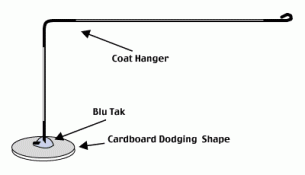Christopher Nisperos
Member
My friend Jean-Marie Francius is a darkroom gadget genius. This afternoon he invited me into his darkroom to show-off his latest innovations. All interesting, but the most impressive was what he came up with to unstick just-washed / just-squeegeed prints from his plexiglass squeegee board: a guitar pick!
This is so obvious that perhaps it's not news... but it's the first time I'd ever seen it. Anyway, he keeps the thing literally close-at-hand by having drilled a little hole into it and attaching it to a cool multi-colored nylon braclet. Ah! Practicality and fashion.
A few other ideas:
-I remember that Al Weber used to use a slab of marble (stays cold) to lay prints upon which were still warm from the press. Their curl would flatten out naturally.
-Al also used wooden thread spools as handles at the end of pull-chains for lights. Safe for wet hands. Enough surface for luminescent tape.
-I know that several of us use an abacus to count the number of prints, rolls or sheets which pass through certain chemicals.
-I keep my dodging tool on a "necklace" around my neck. No more frantic searching after I've hit the timer and forgotten to pick it up
-Velcro on the pencil lets me stick it to the wall.
-Paper trimmer is mounted on glides. Slides under the darkroom bench when not in use. A little garbage sack attached to the side catches the trimmings and tucks away under the board held in place by velcro. I empty it when it gets a little full.
-I have a double-curtain darkroom entrance with as a light-lock system three valances, one on the outside, one between the two curtains and the third on the inside.
Anyone else have tricks, ideas or innovations to share?
Best,
Christopher
.
This is so obvious that perhaps it's not news... but it's the first time I'd ever seen it. Anyway, he keeps the thing literally close-at-hand by having drilled a little hole into it and attaching it to a cool multi-colored nylon braclet. Ah! Practicality and fashion.
A few other ideas:
-I remember that Al Weber used to use a slab of marble (stays cold) to lay prints upon which were still warm from the press. Their curl would flatten out naturally.
-Al also used wooden thread spools as handles at the end of pull-chains for lights. Safe for wet hands. Enough surface for luminescent tape.
-I know that several of us use an abacus to count the number of prints, rolls or sheets which pass through certain chemicals.
-I keep my dodging tool on a "necklace" around my neck. No more frantic searching after I've hit the timer and forgotten to pick it up
-Velcro on the pencil lets me stick it to the wall.
-Paper trimmer is mounted on glides. Slides under the darkroom bench when not in use. A little garbage sack attached to the side catches the trimmings and tucks away under the board held in place by velcro. I empty it when it gets a little full.
-I have a double-curtain darkroom entrance with as a light-lock system three valances, one on the outside, one between the two curtains and the third on the inside.
Anyone else have tricks, ideas or innovations to share?
Best,
Christopher
.
Last edited by a moderator:











 hey - I just thought of one thing/gizmo I use....
hey - I just thought of one thing/gizmo I use....

